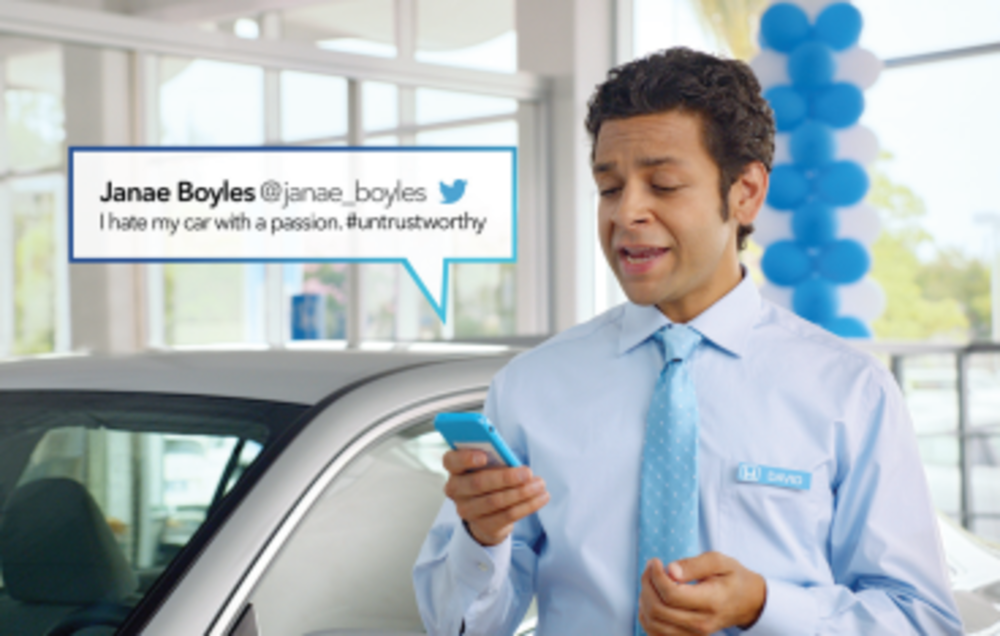Client: American Honda Motor Co., Inc.
Agency: RPA
Objective: Engage directly with consumers using social media to spread awareness of Honda’s annual Summer Clearance Sales Event
The Background: A car isn’t something you buy every day, so staying top-of-mind during that long consideration process is no easy task. But social’s changed all that, says Alicia Jones, manager of social marketing for Honda and Acura at American Honda Motor Co., Inc. “It used to be that a car brand like ours never really had the opportunity to have direct connections with consumers outside hoping they might come in to have their car serviced at the dealership,” Jones says. “Now, through social we have the chance to engage directly on Twitter, YouTube, Facebook—everywhere they are.”
Social media might be effective for direct connections, but it only works if you use it authentically—which is what Honda and its agency RPA were looking to accomplish during the brand’s 2013 Summer Clearance Sales Event.
“Now more than ever people are apathetic and cynical about advertising and marketing, and they’ve found more and more ways of shutting it out,” says Jason Sperling, executive creative director at RPA. “There are times when you need to talk about deals and corporate things, but you also need to keep the engagement and the excitement alive—people appreciate a brand that surprises them.”
In essence, marketing that doesn’t feel like marketing, but rather marketing that’s fun, feels like value, and stands out from the crowd—and during the summer months there’s a big crowd in the car-selling scene.
“Summer is the time of the year when you have 15 different car brands telling you about the great deals you can get on cars,” Sperling says. “People are used to a brand talking at them, but in this day and age it’s so easy—and appreciated—when you actually have a conversation with customers and connect on a more personal level.”
The Strategy: And that’s exactly what Honda did.
First, the auto manufacturer identified an organic, preexisting trend on Twitter: the use of hashtag #wantnewcar by disgruntled people hating on their junkers. For example, “Only in my car does using the left turn signal while on cruise control confuse the hell out of my car! #wantnewcar” and “I want to park my car close to the rickety-est looking tree on my street in hopes of it falling and crushing it. #wantnewcar.”
Capitalizing on this, Honda promoted #wantnewcar, urging Twitter fans to share their car frustrations on July 15 for the chance to receive a real-time personalized Vine response from the brand.
In one amusing example, Honda responded to the tweet “Cause my car is haunted, my driver side window doesn’t go up and my tints are so dark that I cannot see out of them at night #wantnewcar” with a Vine video featuring a med school skeleton standing in front of an Accord. The skeleton addresses the camera with the words “Hey Matt, this Accord is certified 100% ghost free…mostly,” while its arms move around haphazardly. As the skeleton speaks, the automatic windows move up and down, seemingly of their own accord.
Over the course of a single day, Honda and RPA managed to film and create 36 response Vine videos. To react as quickly as possible, often within minutes of the original tweet, the brand and its agency couldn’t wait around for legal to approve an idea—they just had to do it.
“It was a really stripped-down creative process,” Jones says.
The Channels: The #wantnewcar Vine campaign was part of a larger integrated brand campaign that included print, digital, radio, and TV ads, each of which incorpoated user-generated content from Twitter into the creative.
Honda followed up the #wantnewcar effort with another social initiative in August centered on the hashtag #HondaLove, in which the brand again responded to select consumers who’d tweeted at them with real-time personalized Vine videos as a thank you for being Honda fans.
#HondaLove is actually part of a larger Honda effort dubbed “Honda Loves You Back,” that’s been going on for several years, in which the brand reaches out to fans in fun and surprising ways, like paying for a Honda’s owner’s parking and organizing a surprise parade for a driver who’d hit one million miles on his Accord. In total, Honda created and posted 52 #HondaLove response videos on one day in August.
The Results: During the two days Honda responded to select Twitter users with personalized Vine videos, the auto manufacturer generated a total of more than 32 million tweet impressions and 11,000 Twitter mentions and gained nearly 4,000 new followers.
Honda also broke its July sales records, with the Civic, Accord, Odyssey, and CR-V all showing double-digit gains. Although Honda was reticent to say that its social initiatives were the sole factor in its July sales success, the #wantnewcar and #HondaLove were two of the main campaigns running at the time.
The Takeaway: When it comes to social media, Jones advises showing a little humanity. “You can tell the personality of a brand by how it interacts with people online,” Jones says. “It’s been overplayed, people say it a lot, but it’s true: It’s about humanizing the brand.” For that same reason, social media is Honda’s weapon of choice when it comes to amplification. “You can push one-to-many [messages] through TV or print, but online and through social is where we can have a dialogue and a conversation,” Jones says. “It’s where people are already engaging and sharing amongst themselves.”









